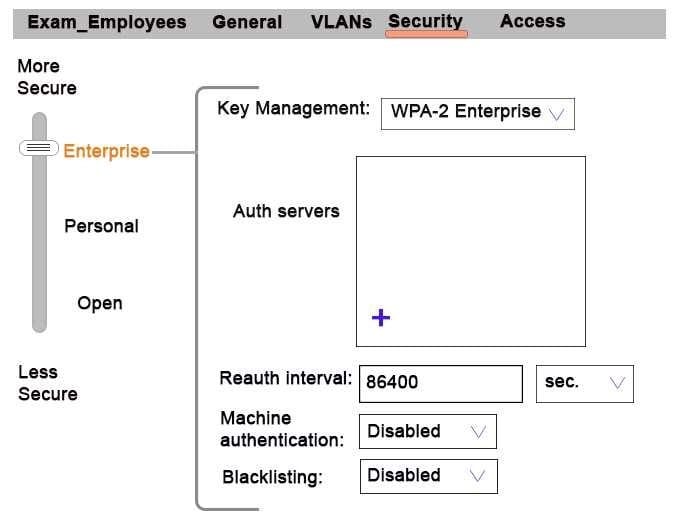HPE6-A70 Online Practice Questions and Answers
Refer to the exhibit.

Network administrators need to set up a WLAN that uses WPA2 encryption and authenticates users with a
preshared key (PSK) that is the same for all users. Administrators do not see where they should specify
the option for the preshared key.
What should the administrators do?
A. Click Personal in the slide bar.
B. Click the + icon in the Authentication server section
C. Return to the first page in the wizard and select the guest option
D. Configure an L3 authentication profile after the WLAN wizard is complete
Which task can an Aruba Air Monitor (AM) perform?
A. Analyze wireless traffic patterns at the application level.
B. Optimize RF through the AP channel and transmit power plans.
C. Analyze RF signals to determine the cause of non-802.11 interference.
D. Help to detect rogue APs in the environment.
A network administrator wants to implement MAC filtering for the wireless network of a local financial firm to ensure that only employees can access the wireless network. What is a potential weakness of this solution?
A. MAC filters cannot be applied with WPA2 encryption.
B. Authorized MAC addresses are visible in plaintext in the air and can be easily spoofed.
C. Many popular clients do not have the capability to connect to WLANs that use MAC filters.
D. MAC filters offer no protection against authorized users who try to connect unauthorized devices.
What does an Aruba Mobility Master (MM) do before it deploys a configuration to a Mobility Controller (MC)?
A. It encrypts the configuration to be deployed and backs it up to a secure archive.
B. It obtains the current configuration, encrypts it, and backs it up to a secure archive.
C. It synchronizes the configuration with templates on Aruba AirWave.
D. It removes any commands that are not supported on that MC or have dependency errors.
Which authentication server option would the network administrator choose to authenticate a wireless user directly against an Active Directory (AD) domain controller without NPS or IAS?
A. LDAP server
B. RFC 3576 server
C. TACACS server
D. RADIUS server
An Aruba Remote AP (RAP) operates in split-tunnel mode. How does the AP forward traffic?
A. It sends all user traffic in a GRE tunnel to a central Mobility Controller (MC), and it sends control traffic in an IPsec tunnel to the controller.
B. It sends traffic designed to the corporate network in an IPsec tunnel to a central Mobility Controller (MC), and it bridges other traffic locally.
C. It sends user and control traffic in two separate IPsec tunnels to the Mobility Controller (MC).
D. It sends all employee and control traffic in a GRE tunnel to a central Mobility Controller (MC), and it bridges all guest traffic locally.
What is one difference between how a network administrator can monitor clients in the Mobility (MM) interface and in the AirWave Management Platform?
A. AirWave shows trends for the past several minutes, while MM shows longer trends.
B. AirWave combines information from more sources, such as RADIUS authenticating servers and APs.
C. AirWave shows the current signal level for the client connection, while MM does not show RF statistics.
D. MM shows user and role information associated with clients, while AirWave does not.
What is an advantage for a network administrator to use AirWave over a Mobility Master (MM)?
A. ability to gather and analyze historical user data, and monitor client association and network usage trends
B. scans wireless client settings and brings those settings in compliance with corporate security policies.
C. ability to monitor and manage a Mobility Controller (MC) to configure the WLAN
D. provides realtime firewall hits for client network troubleshooting
